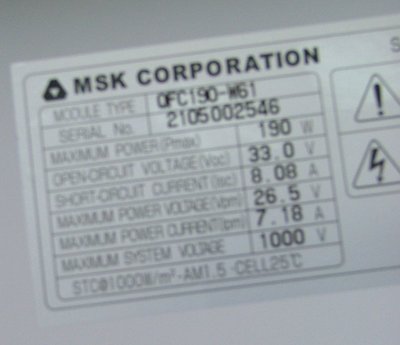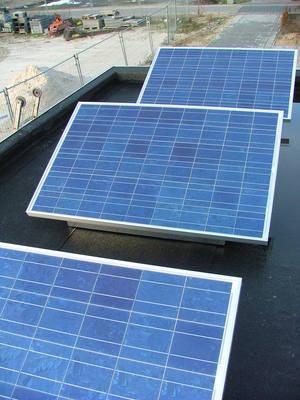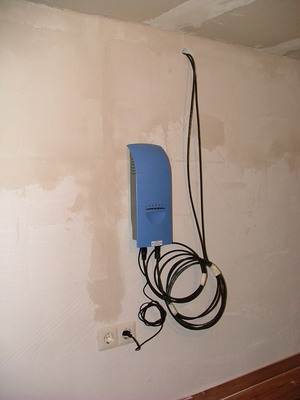After settling down in your own new house, with a new future and lots of new ideas, then it comes to mind: What’s next?
After a while it becomes clear: I want solar energy to be available for my house!! How things went after taking this decision, you can read it in this essay…

Since March 2006 I became a proud owner of a nice house (with garden alligned due south). On this very first beginning the idea of environmental-aware living came to mind. In my house I arranged some first steps to ensure low-energy consumption: appliance of low-energy/high efficiency bulbs (okay, I admit: the ordinary lightbulb are still applied in the store-closet and toilet….). Also the bar and my television where decorated with LED-lights, as the hallway and kitchen. After these modifications, my estimated energy-consumption (for 1-person household) would/should/could be as high as approximately 1.000 kWh. At that time I shared a washingmachine with my parent, whom are living 500 meters away.
Speaking for myself, I am aware of energyconsumption and environmental issues. I try to drive my car as fuel-efficient as can be, use my bicycle more often instead of the car, and apply (when easily incorporated) new alternatives in my household. My technical background I became aware of photovoltaic cells: quite stylish, high-tech look, easy to install and ofcourse: silent! It became more and more clear: These blue panels should decorate my (flat) roof on the garage. As the Dutch government had some regulations and financial support available way back in 2003, I had a flashback: “If only I had bought lots of these babies in that era…”
But now the budget was still sufficient, and in December some extras where paid out, it was time to realize this environmental-friendly choice: Let’s buy a first set of photovoltaic panels.
Investment in solar-based solutions
After some research was done, the decision was clear and taken: a small set was ordered at Oskomera Solar Solutions. 3 panels (brand: MSK) of 190Watt-peak incorporated with a Mastervolt Soladin 600 were delivered in no-time. Even some questions I had, where correctly answered, and so on the day before Christmas the 3 panels where operational.

Details on the specifications of one of the 3 panels MSK QFC-190 W61
Here some technical details/specifications of the MSK-panels:
| Type: | QFC-190W61 |
| Brand: | MSK |
| Power | 190Wp |
| Efficiency | 14,5% |
| Max. voltage | 26,5V |
| Max. current | 7,18 A |
| Weight (per paneel) | 21 kg |
More can be found in the datasheet of MSK.
I had to drive twice with a Subaru Forrester (without trailer) to transport the panels and boxes to my home.
Tip 1: arrange a trailer. It still is a tight fit in a Subaru.. I was a tiny bit too positive on estimations on sizes…
The same day I got the set, I started the installation. All was done in a bit of sunshine as you can imagine in a cold December. The lightboxes where lifted onto the flat roof, followed by the 3 panels. All panels were securely bolted together, and with some sunshine during this job, I could easily allign the panels so no effects on casted shadows would occur.

Tight blue installation 3x 190Wp on top of the garage
Tip 2: Use the sunshine in the winter to ensure you have sufficient distance between each panel. This will avoid losses due to shaded solar-cells (which will destroy the efficiency of the complete solar-string).

Mounted on the flat roof, but without cables attached.
To ensure the panels would survive a storm, I added some ballast. Here I used recycled tiles. After some calculation/estimation there’s at this very moment approx. 35-40kg of weight mounted in the solar-box/lightframe.
The cabling was easy to connect: all panels in this string are connected in series. Therefore: the “Plus” of the first panel would connect to the “Minus” on the second panel. The “Plus” on the second panel, connects to the “Minus” on the third panel. And from the first and third panel back to the Soladin.
Finally I had to drill a hole in the outside wall, which is slightly ascending towards the inside. This prevents rain/moist can enter the garage. The cables where fed through this whole, and the special connectors were mounted. And there I’ve made a mistake: I forgot to place a plastic connector-part on the cable and then the connector. Results: difficult to repair, because the cable doesn’t have a lock to clamp the cable correctly.
But after all: if it’s correctly placed, you’ve never had to look back again. So it’s a pity, but not completely disastrous.
Mounting a MasterVolt Soladin 600
After the cables were fed through, it is time to mount the Soladin onto the wall. Easy does it: drill 2 holes, use 2 screws and attach the rail and Soladin-unit onto this.

The Soladin attached onto the wall and connected to the panels.
I expected the Soladin to be quite heavy, but… it was decent build quality.
After the work had been done, I plugged it onto the net……and nothing happened. Even the status lights didn’t light up. After reading TFM (The Friendly Manual) it was clear: too dark to activate the Soladin…
Okay… so let’s wait till the next day….
First signs of live
The very next day, I returned from my job. Let’s have a look!!
The blue box was active, and the status led (amber coloured) where flashing in a steady pace.
As the manual described: normal operation, no problems. When I inspected the central energy-meter, all meters where still unchanged. Probably it will take some time to generate the first kilowatthour to produce in this low-light conditions in the winter.
Tips & advice
Some other tips which are not yet mentioned, but can be very clever to know:
- Make a call/send a mail to the insurance company so your panels are insured. It won’t cost much, for me it was about 19 euro-cent per month.
- Essent (my utility company) has very little information available on their website about solar-energy. So make a call to the callcenter and ask for registration documents for your solar panels. After a day or 2 these were sent to me, and are very basic to fill-in: type of kWh-meter, number of solar-panels, and total amount of power of these panels.
After all a question raised in my mind: Investments in durable/sustainable objects are deductable from income taxes… Could it be possible to dedict my investment in PV-panels?…. Anyone experiences?? Or ideas? Because THAT would be very handy to know….





1 reply on “My first set of photo-voltaic panels”
please guide me full details and procedure for establishing this busines on commercial basis in pakistan. how much initial minimum investment is neaded? looking forward earliest favourable action please.